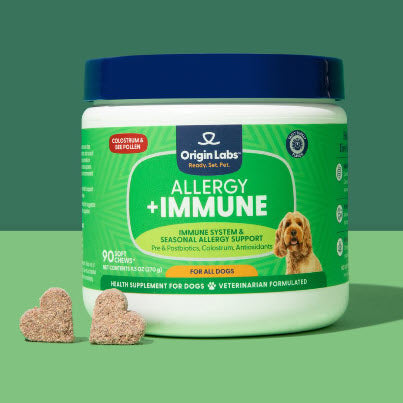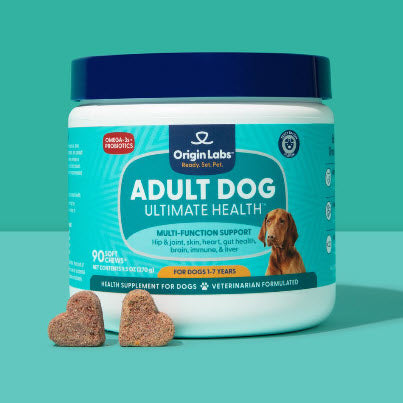Introduction
Joint health is crucial for dogs' overall well-being and quality of life. Like humans, dogs can develop joint problems such as arthritis and hip dysplasia, which can lead to pain, limited mobility, and decreased energy.
This article explores the possible advantages of glucosamine for dogs, a popular supplement for joint health. While glucosamine is not a cure or treatment for these conditions, it might help maintain your dog's joint health and mobility. We aim to provide useful information on how this supplement works and its potential benefits, giving you a realistic understanding of what glucosamine can offer your furry friend.
Why Glucosamine?
A notable product in this field is Revive Mobility Hip & Joint Supplement for Dogs, a top-notch blend of glucosamine designed to naturally support dogs' joint health and mobility. Throughout this article, remember that these supplements are not magical solutions but rather tools that may improve your dog's comfort and physical ability.
In this detailed guide, we will cover the following topics:
- What glucosamine is and how it helps maintain dogs' joint health
- The potential benefits of glucosamine for dogs' joint health
- How to choose the right glucosamine supplement for your dog
- The proper way to give your dog glucosamine supplements
- Additional methods to promote your dog's joint health
Before starting any new dietary supplement routine for your dog, it is essential to consult with a veterinarian.
Understanding Glucosamine for Dogs
Glucosamine, a naturally occurring compound found in the body of animals including dogs, plays a crucial role in maintaining healthy joints. Its primary function is to act as a building block for proteins that help form cartilages, ligaments, and tendons. As dogs age or due to certain factors like genetics, diet, and exercise levels, they may experience a decrease in their natural glucosamine production. This can lead to joint conditions such as arthritis or hip dysplasia.
Glucosamine: A Natural Compound
Glucosamine is produced naturally in the bodies of all mammals. It's part of the biochemical process that creates glycosaminoglycans (GAGs), molecules essential for the formation and repair of various body tissues including cartilage. The creation of GAGs helps keep your dog's joints functioning smoothly by providing cushioning between bones and absorbing shock during movement.
As dogs age, their bodies' ability to produce glucosamine slows down. This can lead to a decrease in GAG production and subsequently poorer health of their joint cartilage. When the cartilage thins or wears away, bones can rub against each other causing pain and inflammation - common symptoms of joint conditions in dogs.
How Glucosamine Works
When supplemented orally, glucosamine gets absorbed into your dog's body where it aids in repairing damaged cartilage and promotes the synthesis of new GAGs. This is possible because glucosamine provides the necessary building blocks for the creation of GAGs which then form new cartilage tissue.
In addition to promoting cartilage health, glucosamine also helps increase the production of joint fluid – or synovial fluid – which lubricates joints and also acts as a shock absorber during movement. These combined actions contribute significantly towards maintaining healthy joints and enhancing your dog's mobility.
Factors Leading to Joint Conditions in Dogs
While decreased glucosamine production due to aging is a natural phenomenon, other factors can also lead to joint conditions in dogs. These include:
- Genetics: Certain dog breeds have a higher predisposition to developing joint issues. For instance, large breed dogs are more likely to develop hip dysplasia.
- Weight: Overweight dogs have extra stress on their joints which can accelerate cartilage wear and tear.
- Diet: Insufficient nutrients for joint support in a dog's diet can compromise the health of their joints.
- Injuries or Trauma: Injuries to a dog's joints can lead to chronic conditions if not treated properly.
Understanding these factors can help you be proactive in preventing or managing your dog’s joint issues. Incorporating a well-researched glucosamine supplement such as the ones offered by Origin Labs, which are known for their quality and effectiveness, into your dog's routine could be an effective part of this strategy.
The Benefits of Glucosamine for Dogs' Joint Health
In our mission to improve the well-being of our beloved pets, it's important to understand how glucosamine can benefit dogs' joint health. Glucosamine is a natural compound that has gained recognition for its potential in supporting the joints of dogs. It plays a crucial role in various aspects such as:
- Providing Cartilage Support and Enhancing Mobility
- Reducing Inflammation
- Deterring Further Joint Degradation
Let's dive deeper into each of these benefits and explore how they contribute to your dog's overall joint health and mobility.
2. Reducing Inflammation and Discomfort
Joint discomfort and inflammation are two common issues that can severely affect a dog's quality of life. One of the key benefits of glucosamine for dogs is its potential anti-inflammatory properties.
How Glucosamine Reduces Inflammation
Glucosamine plays an integral role in our body's natural inflammatory response. It aids in the synthesis of glycosaminoglycans, which are essential building blocks of cartilage. These molecules carry out numerous functions that contribute to joint health, one of which is controlling inflammation. When we supplement our dogs with glucosamine, we essentially help their bodies produce more glycosaminoglycans, thereby reducing inflammation in their joints.
The Connection Between Inflammation and Joint Pain
The reduction in inflammation directly leads to relief from joint pain and discomfort - a benefit many dog owners have reported upon using glucosamine supplements for their beloved pets. By decreasing inflammation in the joints, glucosamine alleviates pressure and friction between bones, leading to less discomfort during movement.
Additional Benefits for Joint Health
Moreover, glucosamine might also aid in the production of hyaluronic acid - a key component of joint fluid that lubricates joints and makes movement smoother. This lubrication further helps to reduce friction between bones during motion, adding another layer of comfort for dogs suffering from joint issues.
Real-Life Stories: The Impact of Glucosamine on Dogs' Comfort
To add some perspective to these benefits:
- Buddy, a 10-year-old Labrador Retriever, had been slowing down due to arthritis-related pain. His owner started giving him a glucosamine supplement daily as recommended by their vet. Within just a few weeks, Buddy's owner noticed significant improvements in his mobility and overall energy level – he was happier during walks and seemed to experience less discomfort after physical activities.
- Molly, a 7-year-old Golden Retriever diagnosed with hip dysplasia, also benefited from glucosamine supplementation. Her owners reported that she seemed more comfortable during longer walks and showed fewer signs of discomfort after physical exertion.
These stories emphasize the power of glucosamine in reducing inflammation and discomfort, helping to restore mobility and range of motion for dogs suffering from joint-related issues. It's worth noting that while individual results may vary, many dog owners have experienced similar positive outcomes when supplementing their dogs with glucosamine.
The Key to Seeing Results: Consistent Supplementation
It's essential to remember that these benefits don't happen overnight. Consistent supplementation, as directed by a veterinarian, is crucial to achieve noticeable improvements in a dog's comfort and mobility.
3. Preventing Further Joint Degeneration
Joint degenerative diseases like osteoarthritis and hip dysplasia are common in dogs and can greatly affect their quality of life. Glucosamine for dogs offers more than just relief from symptoms; it may also help prevent these conditions from worsening.
Why Early Intervention Matters
Starting glucosamine supplements early in a dog's life, especially for breeds prone to joint issues, can make a big difference. Here's how it works:
- Slows Disease Progression: By supporting joint function before severe damage occurs, it's possible to slow down the natural progression of degenerative diseases like osteoarthritis.
- Maintains Joint Fluid: Glucosamine helps keep synovial fluid, which lubricates the joints, at healthy levels. This fluid is crucial for cushioning joints and reducing further wear on cartilage.
- Promotes Cartilage Regeneration: Regular use of glucosamine can stimulate the production of proteoglycans and collagen, key components of cartilage. This process is essential for repairing cartilage damage and may slow down its deterioration.
The Impact on Mobility and Range of Motion
Preserving the integrity of joint components is another way that glucosamine can help:
- Restores Movement: By protecting joint components, glucosamine aids in restoring lost mobility and range of motion caused by joint degeneration.
- Enhances Quality of Life: Better movement leads to a better quality of life. Dogs that can move freely are more likely to engage in physical activity, which is good for their overall health.
What Dog Owners Are Saying
Many dog owners have noticed positive changes in their pets after starting them on a glucosamine regimen:
"My dog seems more eager to climb stairs now!"
"He's back to his playful self since starting the supplements."
"Our older dog has shown a burst of energy lately!"
Tailoring Glucosamine Supplementation
It's important to remember that while many dogs see improvements with glucosamine supplements, results may vary:
- Individual Needs: Every dog is different, and the effectiveness of glucosamine can depend on factors like age, breed, the severity of joint issues, and any other existing health conditions.
What Research Says About Joint Diseases
Scientists are continually studying how glucosamine affects joint degenerative diseases:
- Studies suggest that glucosamine supplements could help manage symptoms linked to osteoarthritis and hip dysplasia.
- Veterinarians often recommend glucosamine as part of a multi-modal approach to maintaining joint health.
By understanding these key points about how glucosamine can help prevent further joint degeneration in dogs, pet owners can make more informed decisions about their furry friend's well-being.
Choosing the Right Glucosamine Supplement for Your Dog
As a responsible pet owner, ensuring your dog's optimal health is achieved through more than just love and affection. It's also about making informed decisions regarding their diet and supplementation. One of these crucial decisions revolves around selecting a quality glucosamine supplement for your canine companion.
Ingredients
The first factor to consider when choosing a glucosamine supplement for your dog is the list of ingredients. While glucosamine is the star player, other ingredients play supporting roles that enhance its effectiveness.
- Glucosamine: As we have discussed earlier, glucosamine plays a vital role in maintaining and repairing joint cartilage. Glucosamine supplements usually come in two forms: glucosamine sulfate and glucosamine hydrochloride. Both are effective but may differ in absorption rates.
- Chondroitin sulfate: Often paired with glucosamine, chondroitin sulfate helps retain water in the cartilage to maintain its elasticity and shock-absorbing properties.
- Methylsulfonylmethane (MSM): This organic sulfur compound further supports joint health by reducing inflammation and promoting antioxidant activity.
Ensure the product you choose doesn't contain artificial colors or flavors, as these can cause adverse reactions in some dogs.
Formulation
The formulation of the supplement is another important aspect to consider. Glucosamine supplements come in various forms such as tablets, chews, powders, or liquids.
- Tablets: These are typically easy to administer but might be harder for some dogs to swallow.
- Chews: This form is often flavored to make it more palatable for dogs making it easier to administer.
- Powders & Liquids: These can be mixed into your dog's food, providing an easy way to ensure they're getting their daily dose.
Your dog's preference and lifestyle will determine which form is best.
Manufacturing Standards
Lastly, consider the manufacturing standards of the product. Supplements aren't regulated by the FDA, making it crucial to choose a product from a reputable company that follows rigorous quality control measures.
Look for products that are vetted by the National Animal Supplement Council (NASC). This organization provides a seal of approval to products that meet their high-quality standards, ensuring they're safe and effective for your pet.
Keep in mind, while glucosamine supplements have numerous benefits, they should complement a balanced diet and regular exercise routine – not replace them.
Choosing a high-quality glucosamine supplement might seem overwhelming at first glance. However, by considering these factors, you can make an informed choice that supports your dog's joint health and overall well-being.
Administering Glucosamine Supplements to Dogs
Administering glucosamine supplements to your dog requires attention to detail to ensure safety and effectiveness. When it comes to the correct dosage and administration methods, several factors need consideration. Dog owners should be aware of the weight and size of their pet, the specific product's instructions, and any potential side effects that could arise.
Determining the Correct Dosage
The correct dosage of glucosamine for a dog primarily depends on its weight and size. The general guideline is approximately 20 milligrams of glucosamine per pound of body weight daily. However, this can vary based on the concentration of glucosamine in the supplement and individual needs of the dog. It is essential to:
- Read the Product Label: Each supplement will come with its own set of instructions regarding dosage.
- Consult with Your Veterinarian: Before starting supplementation, it is crucial to get professional advice, especially if your dog has underlying health conditions or is already on medication.
- Adjust as Necessary: Some dogs may require a higher or lower dose depending on how they respond to the supplement.
Administration Methods
Glucosamine supplements for dogs come in various forms – tablets, chews, powders, and liquids. Selecting an administration method that suits both you and your pet will encourage regular intake and can enhance compliance.
- Tablets: Can be hidden in food or a treat if your dog is resistant to taking pills.
- Chews: Many are flavored and can be given as a treat.
- Powders: Can be mixed into wet food for easy consumption.
- Liquids: Can be added to water or poured over dry food.
It's important to follow these steps:
- Introduce gradually: Start with a smaller dose and increase it to give your dog time to adjust.
- Maintain consistency: Administer the supplement at the same time each day.
- Monitor your pet: Observe for any changes in behavior or physical condition after starting supplementation.
Frequency of Administration
Most glucosamine supplements are designed for daily use, but some may recommend more frequent dosages during initial stages or for severe cases. Always adhere to the manufacturer's recommended frequency unless advised otherwise by your vet.
Potential Side Effects
While glucosamine is generally safe for dogs, some may experience side effects such as:
- Increased thirst and urination
- Fatigue or insomnia
- Allergic reactions (particularly in dogs allergic to shellfish)
- Gastrointestinal upset like vomiting or diarrhea
If any of these symptoms occur, it's important to consult with your veterinarian promptly.
By understanding these key points about administering glucosamine supplements, you can effectively support your dog's joint health while minimizing risks. With careful consideration of dosage, administration methods, frequency, and possible side effects, you help ensure a positive outcome for your canine companion's mobility and well-being.
Other Ways to Support Your Dog's Joint Health
While glucosamine supplements can be a valuable addition to your dog's health regime, there are other measures that are equally important for maintaining good joint health. These include regular exercise, a balanced diet rich in nutrients, and effective weight management.
Regular Exercise
Regular physical activity is vital in keeping your dog healthy and active. It aids in the maintenance of a healthy body weight, which reduces strain on the joints. Suitable activities may vary depending on your dog's age, breed, and general health condition. For example, swimming is an excellent low-impact exercise that can strengthen muscles without putting too much pressure on the joints. Seek advice from a vet to determine the most suitable exercise routine for your dog.
Balanced Diet
A balanced diet that is rich in nutrients can help support your dog's joint health. Incorporating green lipped mussels into their diet can enhance the effects of glucosamine supplements as they contain omega-3 fatty acids known to have anti-inflammatory properties beneficial for joint health.
Additionally, foods rich in antioxidants such as fruits and vegetables can improve overall cellular health and reduce inflammation. Antioxidants help counteract free radicals in the body that cause oxidative stress, which could lead to inflammation and arthritis.
Weight Management
Weight management plays a crucial role in maintaining your pet's joint health. Excess weight puts additional strain on a dog’s joints, leading to wear and tear over time. This could exacerbate conditions like osteoarthritis or hip dysplasia.
A veterinarian or canine nutritionist can provide guidance on creating a balanced diet plan that helps maintain an ideal body weight for your pet while ensuring they receive all necessary nutrients.
Combining glucosamine supplements with these supportive measures will provide a holistic approach towards maintaining your dog’s joint health. Remember that each dog is unique and what works best might vary from one dog to another. Hence, it is always recommended to consult a vet before making significant changes to your dog's routine or diet.
Conclusion
The potential benefits of glucosamine for dogs are substantial, particularly when considering its ability to support joint health and enhance mobility. Through the synthesis of glycosaminoglycans, glucosamine plays a critical role in repairing damaged cartilage and maintaining the fluidity necessary for joint function. Dog owners have observed marked improvements in their pets' comfort levels and activity after incorporating glucosamine into their health routine.
Before integrating any new dietary supplement into your dog's regimen, it is crucial to seek guidance from a veterinarian. They can provide personalized advice based on your dog's unique health profile, ensuring that glucosamine supplementation is both safe and effective for your canine companion.
Revive Mobility stands out as a high-quality joint health supplement designed to support the long-term mobility and overall well-being of dogs. By selecting Revive Mobility, you are making a commitment to your dog's joint health.
Try Revive Mobility Today Support Your Dog’s Active Lifestyle with Our Trusted Glucosamine Supplement
FAQs (Frequently Asked Questions)
What is glucosamine and how does it work in the body?
Glucosamine is a naturally occurring compound that plays a key role in maintaining healthy joints. It helps to support healthy joints, which can improve overall mobility and reduce stiffness in dogs.
What are the potential benefits of supplementing with glucosamine for dogs' joint health?
Supplementing with glucosamine for dogs' joint health may provide benefits such as promoting mobility, supporting joint health, and lubricating joints.
What factors should be considered when choosing a glucosamine supplement for dogs?
When choosing a glucosamine supplement for dogs, it's important to consider factors such as ingredients, formulation (e.g. tablets, chews), and manufacturing standards to ensure high quality.
How should glucosamine supplements be administered to dogs?
To properly administer glucosamine supplements to dogs, it's important to determine the correct dosage based on weight/size, establish the frequency of administration, and watch out for potential side effects.
In addition to using glucosamine supplements, what other measures can be taken to support a dog's joint health?
In addition to using glucosamine supplements, other measures such as regular exercise routines, balanced diets rich in nutrients for joint support, and weight management strategies for overweight dogs can complement the maintenance of good joint health.








